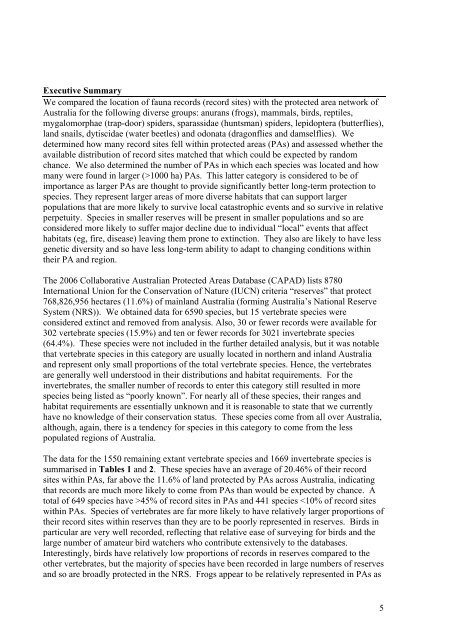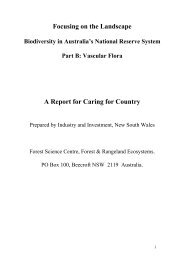Biodiversity in Australia's National Reserve System - Part ... - BushBlitz
Biodiversity in Australia's National Reserve System - Part ... - BushBlitz
Biodiversity in Australia's National Reserve System - Part ... - BushBlitz
Create successful ePaper yourself
Turn your PDF publications into a flip-book with our unique Google optimized e-Paper software.
Executive Summary<br />
We compared the location of fauna records (record sites) with the protected area network of<br />
Australia for the follow<strong>in</strong>g diverse groups: anurans (frogs), mammals, birds, reptiles,<br />
mygalomorphae (trap-door) spiders, sparassidae (huntsman) spiders, lepidoptera (butterflies),<br />
land snails, dytiscidae (water beetles) and odonata (dragonflies and damselflies). We<br />
determ<strong>in</strong>ed how many record sites fell with<strong>in</strong> protected areas (PAs) and assessed whether the<br />
available distribution of record sites matched that which could be expected by random<br />
chance. We also determ<strong>in</strong>ed the number of PAs <strong>in</strong> which each species was located and how<br />
many were found <strong>in</strong> larger (>1000 ha) PAs. This latter category is considered to be of<br />
importance as larger PAs are thought to provide significantly better long-term protection to<br />
species. They represent larger areas of more diverse habitats that can support larger<br />
populations that are more likely to survive local catastrophic events and so survive <strong>in</strong> relative<br />
perpetuity. Species <strong>in</strong> smaller reserves will be present <strong>in</strong> smaller populations and so are<br />
considered more likely to suffer major decl<strong>in</strong>e due to <strong>in</strong>dividual “local” events that affect<br />
habitats (eg, fire, disease) leav<strong>in</strong>g them prone to ext<strong>in</strong>ction. They also are likely to have less<br />
genetic diversity and so have less long-term ability to adapt to chang<strong>in</strong>g conditions with<strong>in</strong><br />
their PA and region.<br />
The 2006 Collaborative Australian Protected Areas Database (CAPAD) lists 8780<br />
International Union for the Conservation of Nature (IUCN) criteria “reserves” that protect<br />
768,826,956 hectares (11.6%) of ma<strong>in</strong>land Australia (form<strong>in</strong>g Australia’s <strong>National</strong> <strong>Reserve</strong><br />
<strong>System</strong> (NRS)). We obta<strong>in</strong>ed data for 6590 species, but 15 vertebrate species were<br />
considered ext<strong>in</strong>ct and removed from analysis. Also, 30 or fewer records were available for<br />
302 vertebrate species (15.9%) and ten or fewer records for 3021 <strong>in</strong>vertebrate species<br />
(64.4%). These species were not <strong>in</strong>cluded <strong>in</strong> the further detailed analysis, but it was notable<br />
that vertebrate species <strong>in</strong> this category are usually located <strong>in</strong> northern and <strong>in</strong>land Australia<br />
and represent only small proportions of the total vertebrate species. Hence, the vertebrates<br />
are generally well understood <strong>in</strong> their distributions and habitat requirements. For the<br />
<strong>in</strong>vertebrates, the smaller number of records to enter this category still resulted <strong>in</strong> more<br />
species be<strong>in</strong>g listed as “poorly known”. For nearly all of these species, their ranges and<br />
habitat requirements are essentially unknown and it is reasonable to state that we currently<br />
have no knowledge of their conservation status. These species come from all over Australia,<br />
although, aga<strong>in</strong>, there is a tendency for species <strong>in</strong> this category to come from the less<br />
populated regions of Australia.<br />
The data for the 1550 rema<strong>in</strong><strong>in</strong>g extant vertebrate species and 1669 <strong>in</strong>vertebrate species is<br />
summarised <strong>in</strong> Tables 1 and 2. These species have an average of 20.46% of their record<br />
sites with<strong>in</strong> PAs, far above the 11.6% of land protected by PAs across Australia, <strong>in</strong>dicat<strong>in</strong>g<br />
that records are much more likely to come from PAs than would be expected by chance. A<br />
total of 649 species have >45% of record sites <strong>in</strong> PAs and 441 species






